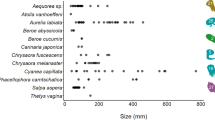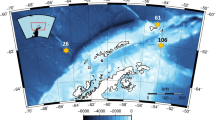Abstract
Growth and grazing loss rates of naturalPhaeocystis sp. single cells were measured using a seawater dilution technique. Measurements were performed during an intensePhaeocystis sp. bloom in the North Sea between 19 April and 5 May 1988. Experimental results yielded rapid carbon turnover rates. Population growth rates varied from 0.033 to 0.098 h−1, grazing loss rates from 0.037 to 0.174 h−1. From measured growth rates, average doubling rages of 1.3 doublings d−1 were calculated. The growth rates would have resulted in maximum carbon production rates of 146 mg C m−3 d−1. Grazing rates increased in the course of the bloom and exceeded growth rates at the end. Grazing loss was caused primarily by microzooplankton feeding. Ciliates and heterotrophic dinoflagellates were identified as the major potential consumers of single cells ofPhaeocystis sp. at the beginning of the bloom. The grazing impact of larger microzooplankton species appeared to increase during the progressing bloom.
Similar content being viewed by others
Literature cited
Admiraal, W., Venekamp, L. A. H. (1986). Significance of tintinnid grazing during blooms ofPhaeocystis pouchetii (Haptophyceae) in Dutch coastal waters. Neth. J. Sea Res. 20: 61–66
Blackbourn, D. J. (1974). The feeding biology of tintinnid Protozoa and some other inshore microzooplankton. Ph.D. thesis, University of British Columbia, Vancouver
Capriulo, G. M. (1982). Feeding of field collected tintinnid microzooplankton on natural food. Mar. Biol. 71: 73–86
Capriulo, G. M., Carpenter, E. J. (1980). Grazing by 35 to 202µm microzooplankton in Long Island Sound. Mar. Biol. 56: 319–326
Davis, P. G., Sieburth, J. McN. (1984). Estuarine and oceanic microflagellate predation of actively growing bacteria: estimation by frequency of dividing-derived bacteria. Mar. Ecol. Prog. Ser 19: 237–246
Gieskes, W. W. C., Kraay, G. W. (1975). The phytoplankton spring bloom in Dutch coastal waters in the Norht sea. Neth. J. Sea Res. 91: 66–196
Grimm, N., Weisse, T. (1985). Die Temperaturabhängigkeit des Wachstums vonPhaeocystis pouchetti in Batchkulturen. Helgoländer Meeresunters. 39: 201–211
Heinbokel, J. F. (1978). Studies on the functional role of tintinnids in the southern California Bight. II. Grazing rates on field populations. Mar. Biol. 47: 191–197
Hollowday, E. D. (1949). A preliminary report on the Plymouth marine and brackish-water Rotifera. J. mar. biol. Ass. U.K. 28: 239–254
Huntley, M. E., Tande, K., Eilertsen, H. C. (1987). On the trophic fate ofPhaeocystis pouchetti (Hariot). II. Grazing rates ofCalanus hyperboreus (Kroyer) on diatoms and different size categories ofPhaeocystis pouchetii. J. exp. mar. Biol. Ecol. 110: 197–212
Jahnke, J. (1989). The light and temperature dependence of growth rate and elemental composition ofPhaeocystis globosa Scherffel andP. pouchetii (Har.) Lagerh. in batch cultures. Neth. J. Sea Res. 23: 15–21
Jahnke, J., Baumann, E. M. (1987). Differentiation betweenPhaeocystis pouchetti (Har.) Lagerheim andPhaeocystis globosa Scherffel. I. Colony shapes and temperature tolerances. Hydrobiol. Bull. 21: 141–147
Joiris, C. et al. (1982). A budget of carbon recycling in the Belgian coastal zone: relative roles of zooplankton, bacterioplankton and benthos in the utilization of primary production. Neth. J. Sea Res. 16: 260–275
Kayser, H. (1970). Experimental-ecological investigations onPhaeocystis pouchetii (Haptophyceae): cultivation and waste water test. Helgoländer wiss. Meeresunters. 20: 195–212
Kornmann, P. (1955) Beobachtungen an Phaeocystis-Kulturen. Helgoländer wiss. Meeresunters. 5: 218–233
Lancelot, C., Billen, G., Rousseau, V. (1989). Joint EEC project on the dynamics ofPhaeocystis blooms in nutrient enriched coastal zones. 1st Ann. Prog. Rep. University of Brussels, Brussels
Lancelot, C., Billen, G., Sournia, A., Weisse, T., Colijn, F., Veldhuis, M. J. V., Davies, A., Wassman, P. (1987).Phaeocystis blooms and nutrient enrichment in the continental coastal zones of the North Sea. Ambio 16: 38–46
Lancelot, C., Mathot, S. (1987). Dynamics of aPhaeocystis-dominated spring bloom in Belgian coastal waters. I. Phytoplanktonic activities and related parameters. Mar. Ecol. Prog. Ser. 37: 239–248
Landry, M. R., Hassett, R. P. (1982). Estimating the grazing impact of marine micro-zooplankton. Mar. Biol. 67: 283–288
Landry, M. R., Hassett, R. P., Fagerness, V., Downs, J., Lorenzen, C. J. (1984). Effect of food acclimation on assimilation efficiency of Calanus pacificus. Limnol. Oceanogr. 29: 361–364
Martens, P. (1981). On theAcartia species in the northern Wadden Sea of Sylt. Kieler Meeresforsch. (Sonderh.) 5: 153–163
Nihoul, J. C. J. (1983). Hydrodynamic models of shallow continental seas. In: Nihoul, J. C. J., Wollast R. (eds.) Hydrodynamic and dispersion models. Int. Counc. Explor. Sea Comm. Meet. (Pelagic Fish Comm.) E: 40: 7–198
Rassoulzadegan, F., Etienne, M. (1981). Grazing rate of the tintinnidStenosemella ventricosa (Clap. & Lachm.) Jörg. on the spectrum of the natural occurring particulate matter from a Mediterranean neritic area. Limnol. Oceanogr. 26: 258–270
Reck, E. M. (1987). Zur Ökologie der pelagischen Ciliaten des Plussees. Ph.D. thesis, University of Kiel, Kiel
Schnack, S. B. (1983). On the feeding of copepods onThalassiosira partheneia from the northwest African upwelling area. Mar. Ecol. Prog. Ser. 11: 49–53
Smetacek, V., Bodungen, B. von, Knoppers, B., Peinert, R., Pollehne, F., Stegmann, P., Zeitzschel, B. (1984). Seasonal stages characterizing the annual circle of an inshore pelagic system. Rapp. P.-v. Réun. Cons. perm. int. Explor. Mer 183: 126–135
Spittler, P. (1973). Feeding experiments with tintinnids. Oikos (suppl.) 15: 128–132
Tande, K. S., Bamstedt, U. (1987). On the trophic fate ofPhaeocystis pouchetii (Hariot). I. Copepod feeding rates on solitary cells and colonies ofPhaeocystis pouchetii. Sarsia 72: 313–320
Turley, C. M., Newell, R. C., Robins, D. B. (1986). Survival strategies of two small marine ciliates and their role in regulating bacterial community structure under experimental conditions. Mar. Ecol. Prog. Ser. 33: 59–70
Utermöhl, H. (1958). Zur Vervollkommnung der quantitativen Phytoplankton-Methodik. Mitt. int. Verein. theor. angew. Limnol. 9: 1–38
Veldhuis, M. J. W., Colijn, F., Venekamp, L. A. H. (1986). The spring bloom ofPhaeocystis pouchetii (Haptophyceae) in Dutch coastal waters. Neth. J. Sea Res. 20: 37–48
Verity, P. G. (1985). Grazing, respiration, excretion and growth rates on tintinnids. Limnol. Oceanogr. 30: 1268–1282
Verity, P. G., Villareal, T. A., Smayda, T. J. (1988). Ecological investigations of blooms of colonialPhaeocystis pouchetii. I. Abundance, biochemical composition, and metabolic rates. J. Plankton Res. 10: 219–248
Verity, P. G., Smayda, T. J. (1989). Nutritional value ofPhaeocystis pouchetii (Prymnesiophyceae) and other phytoplankton forAcartia spp. (Copepoda): ingestion, egg production, and growth of nauplii. Mar. Biol. 100: 161–171
Weisse, T. (1983) Feeding of calanoid copepods in relation toPhaeocystis pouchetii blooms in the German Wadden Sea area of Sylt. Mar. Biol. 74: 87–94
Weisse, T. (1990). Trophic interactions among heterotrophic microplankton, nanoplankton, and bacteria in Lake Constance. Hydrobiologia 191: 111–122
Weisse, T., Müller, H., Pinto-Coelho, R. M., Schweizer, A., Springmann, D., Baldringer, G. (1990). Response of the microbial loop to the phytoplankton spring bloom in a large prealpine lake. Limnol. Oceanogr. (in press)
Weisse, T., Scheffel-Möser, U. (1990). Morphometric characteristics and carbon content ofPhaeocystis cf.pouchetii (Prymnesiophyceae). Botanica Mar. 33: 197–203
Author information
Authors and Affiliations
Additional information
Communicated by O. Kinne, Oldendorf/Luhe
Rights and permissions
About this article
Cite this article
Weisse, T., Scheffel-Möser, U. Growth and grazing loss rates in single-celledPhaeocystis sp. (Prymnesiophyceae). Mar. Biol. 106, 153–158 (1990). https://doi.org/10.1007/BF02114686
Accepted:
Issue Date:
DOI: https://doi.org/10.1007/BF02114686




